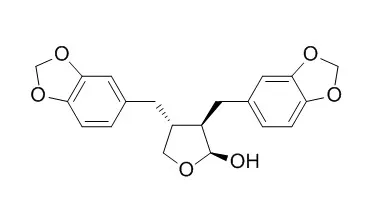| In vitro: |
| Journal of Enzyme Inhibition and Medicinal Chemistry, 01 Apr 2009, 24(2):599-606. | | Cubebin and derivatives as inhibitors of mitochondrial complex I. Proposed interaction with subunit B8.[Reference: WebLink] |
METHODS AND RESULTS:
The effects on mitochondrial respiration and complex I NADH oxidase activity of Cubebin and derivatives were evaluated. The compounds inhibited the state 3 glutamate/malate-supported respiration of hamster liver mitochondria with IC(50) values ranging from 12.16 to 83.96 microM. NADH oxidase reaction was evaluated in submitochondrial particles.
CONCLUSIONS:
The compounds also inhibited this activity, showing the same order of potency observed for effects on state 3 respiration, as well as a tendency towards a non-competitive type of inhibition (K(I) values ranging from 0.62 to 16.1 microM). A potential binding mode of these compounds with complex I subunit B8, assessed by docking calculations, is proposed. | | Bioorganic & Medicinal Chemistry Letters, 2016,26(7):1767-1771. | | Anticancer activity studies of cubebin isolated from Piper cubeba and its synthetic derivatives.[Reference: WebLink] |
METHODS AND RESULTS:
(−)-Cubebin, isolated from the seeds of Piper cubeba, and its five different types of derivatives (a total of 17), with varying functionalities, were tested for their in vitro anticancer activity against six human cancer cell lines (A549, K562, SiHa, KB, HCT116 and HT29) using MTT assay. Cubebin as well as its derivatives containing lactone and amide groups showed significant anticancer activity. In some of the tested cell lines, the amide derivatives showed higher activity.
CONCLUSIONS:
Morphological analysis indicated that these compounds act through apoptosis mediated pathway of cell death and we expect that these results will pave new paths in the development of novel anticancer agents by the derivatization of (−)-Cubebin. |
|
| In vivo: |
| The Indian Journal of Medical Research, 01 Aug 2017, 146(2):255-259. | | Neuroprotective effect of Cubebin: A dibenzylbutyrolactone lignan on scopolamine-induced amnesia in mice.[Reference: WebLink] | Acetylcholinesterase (AChE) inhibitors represent a major class of drugs which provide symptomatic relief and improvement in cognitive function in Alzheimer's disease (AD).
METHODS AND RESULTS:
In this study, Cubebin, a dibenzylbutyrolactone lignan, was isolated from Piper cubeba and investigated for its AChE inhibitory activity in an attempt to explore its potential for memory-enhancing activities in mice.Molecular docking of Cubebin was carried out followed by in vitro AChE activity. Mice were treated with Cubebin (25 & 50 mg/kg; i.p.), for three days and memory impairment was induced by scopolamine (3 mg/kg; i.p.). Memory function was evaluated by Morris water maze (MWM) test. Biochemical parameters of oxidative stress and cholinergic function were estimated in brain.Molecular docking study revealed that Cubebin was well bound within the binding site of the AChE enzyme showing interactions such as π-π stacking and hydrogen bonding with residues present therein. Cubebin inhibited AChE enzyme in an in vitro assay with IC50value of 992 μM. Scopolamine administration caused a significant impairment of learning and memory in mice, as indicated by a marked decrease in MWM performance. Scopolamine administration also produced a significant enhancement of brain AChE activity and oxidative stress in mice brain. Pre-treatment of Cubebin (25 and 50 mg/kg; i.p.) significantly prevented scopolamine-induced learning and memory deficits along with attenuation of scopolamine-induced rise in brain AChE activity and oxidative stress level.Cubebin showed promising protective activity in scopolamine-induced spatial memory impairment in mice.
CONCLUSIONS:
This could be attributed to its brain AChE inhibition and antioxidant activity. |
|






 Cell. 2018 Jan 11;172(1-2):249-261.e12. doi: 10.1016/j.cell.2017.12.019.IF=36.216(2019)
Cell. 2018 Jan 11;172(1-2):249-261.e12. doi: 10.1016/j.cell.2017.12.019.IF=36.216(2019) Cell Metab. 2020 Mar 3;31(3):534-548.e5. doi: 10.1016/j.cmet.2020.01.002.IF=22.415(2019)
Cell Metab. 2020 Mar 3;31(3):534-548.e5. doi: 10.1016/j.cmet.2020.01.002.IF=22.415(2019) Mol Cell. 2017 Nov 16;68(4):673-685.e6. doi: 10.1016/j.molcel.2017.10.022.IF=14.548(2019)
Mol Cell. 2017 Nov 16;68(4):673-685.e6. doi: 10.1016/j.molcel.2017.10.022.IF=14.548(2019)